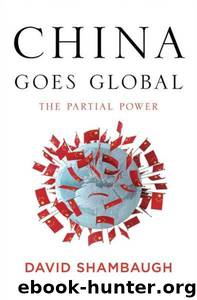China Goes Global by David Shambaugh

Author:David Shambaugh [Shambaugh, David]
Language: eng
Format: epub
Tags: History, General, Political Science, Asia, China, International Relations
ISBN: 9780199323692
Google: W6fPX_duoGcC
Amazon: 0199860149
Publisher: Oxford University Press
Published: 2013-01-17T16:00:00+00:00
Telecoms
The global telecom industry is very crowded, very competitive, and very dynamic. Huawei is the one of the few Chinese firms to have successfully gone global by the aforementioned criteria, and it is thus considered by many to be China’s most successful multinational corporation.500 By 2011 Huawei had become the world’s second-largest provider of wireless telecommunications, networking equipment, and internet technology (after Cisco Systems), producing everything from routers to smart phones and tablet computers. Huawei reported revenues of $28 billion in 2010 and aims to reach $50 billion by 2015. Headquartered in Shenzhen, Huawei now operates in 140 countries.
Huawei was founded in 1987 by Ren Zhengfei, a former People’s Liberation Army officer with twenty-five years of service in the PLA’s engineering and logistics corps. Ren built the company from an initial investment of 21,000 renminbi (about $3,300 at the current exchange rate) and manufacturing digital switches into a multibillion-dollar global telecommunications giant.501 In 2010 Huawei grossed total revenues of $27.1 billion, with a profit of more than $4.3 billion. Ren’s corporate strategy and secret is an old one: to produce good—or better—quality equipment than the competition at (much) cheaper princes, and providing twenty-four, seven technical service to customers. But Ren’s military origins and the company’s original links to the PLA have clouded its reputation in Europe, Australia, and the United States, where a number of Huawei’s attempted acquisitions and investments were nixed on national security grounds by government authorities. The fear is that Huawei’s equipment could pilfer industrial secrets, eavesdrop on communications or shut them down during a conflict, and hack networks.
For its part, Huawei claims that it is a “collective enterprise” and an employee-owned company with 120,000 staff, having no ties with either the Chinese government or military. Its 2010 Annual Report states that “Huawei Holding (the parent company) is solely owned by employees of the company, without any third parties, including government bodies, holding any of its shares.”502 Nonetheless, Huawei’s corporate structure and accounting remain opaque and its links to the PLA remain in question. In an effort to calm such concerns, Huawei began in 2012 to offer foreign governments “security guarantees” that include foreign government access to the company’s source codes and security checks of equipment and software.503
Despite national security concerns in some countries, Huawei has been able to expand its corporate footprint globally. It pursues what one Huawei executive described as a “Maoist strategy of surrounding the cities from the countryside.”504 That is, the executive recounted, the company calculated its global expansion in three phases: (1) establishing itself in Asia, Africa, and Latin America; (2) expanding into Europe; and (3) gaining a foothold in North America. Phase 1 has been very successful, with these regions accounting for $23 billion in global revenue during 2008 (75 percent of Huawei’s total revenue), according to its chief executive in Brazil. The 2010 Annual Report indicates that the 75–25 (global vs. domestic sales) revenue stream has continued. More than half the company’s revenue in 2010 came from sales of devices, shipping 30 million smart phones and tablets abroad.
Download
This site does not store any files on its server. We only index and link to content provided by other sites. Please contact the content providers to delete copyright contents if any and email us, we'll remove relevant links or contents immediately.
| Anthropology | Archaeology |
| Philosophy | Politics & Government |
| Social Sciences | Sociology |
| Women's Studies |
The Secret History by Donna Tartt(18786)
The Social Justice Warrior Handbook by Lisa De Pasquale(12098)
Thirteen Reasons Why by Jay Asher(8759)
This Is How You Lose Her by Junot Diaz(6721)
Weapons of Math Destruction by Cathy O'Neil(6100)
Zero to One by Peter Thiel(5650)
Beartown by Fredrik Backman(5565)
The Myth of the Strong Leader by Archie Brown(5390)
The Fire Next Time by James Baldwin(5215)
How Democracies Die by Steven Levitsky & Daniel Ziblatt(5105)
Promise Me, Dad by Joe Biden(5048)
Stone's Rules by Roger Stone(5000)
100 Deadly Skills by Clint Emerson(4815)
A Higher Loyalty: Truth, Lies, and Leadership by James Comey(4813)
Rise and Kill First by Ronen Bergman(4669)
Secrecy World by Jake Bernstein(4608)
The David Icke Guide to the Global Conspiracy (and how to end it) by David Icke(4571)
The Farm by Tom Rob Smith(4412)
The Doomsday Machine by Daniel Ellsberg(4386)
